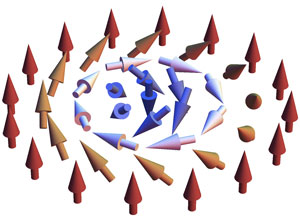Aug. 17, 2012 Research Highlight Physics / Astronomy
Magnetic vortices with electric sense
Observation of magnetic vortices in an insulating material suggests a route to energy-efficient electronic devices
 Figure 1: An artistic representation of a magnetic vortex. In magnetic materials, spins—represented here as arrows—can adopt arrangements such as the skyrmion structure shown above that are robust against external perturbations. Reproduced, with permission, from Ref. 1 © 2012 AAAS
Figure 1: An artistic representation of a magnetic vortex. In magnetic materials, spins—represented here as arrows—can adopt arrangements such as the skyrmion structure shown above that are robust against external perturbations. Reproduced, with permission, from Ref. 1 © 2012 AAAS
In the field of magnetic materials, a rapidly expanding area of study concerns stable nanometer-scale spin arrangements. Spins are the fundamental magnetic entities in solids, and patterns made of several spins could be useful components in applications such as memory devices. Applied physicist Shinichiro Seki and his team in Japan, including members from the RIKEN Advanced Science Institute, Wako, now report the observation of one such spin pattern, called a ‘skyrmion’, in a material where it can be manipulated with electrical fields1. This finding could help to make future devices based on spin structures more energy-efficient.
Skyrmions are magnetic structures in which spins adopt a vortex pattern (Fig. 1). They are a famed example of spin textures that are, by virtue of their specific spatial arrangements, robust against external perturbations. This robustness is important for device applications. Also, skyrmions are only tens of nanometers in diameter, making them promising candidates for use in compact electronic components
In the past few years, scientists have observed skyrmions in a range of metals, which are conducting materials. Now, Seki and his colleagues have detected skyrmions in an insulating material, Cu2OSeO3. In addition to being non-conductive, Cu2OSeO3 has another important property: the spins—that is, the elementary magnetic units—are ordered in well-defined patterns as are their electric counterparts. “Materials with both magnetic and electric order are called multiferroics,” explains Seki. “For Cu2OSeO3, emergence of electric ordering has now been reported for the first time.”
The coupling of magnetic and electric order in this material has important ramifications. “Our analysis suggests that each skyrmion can carry some form of electric order, which implies that the dynamics of skyrmions is controllable through external electric fields,” says Seki. This kind of skyrmion manipulation is not possible in conducting materials, where electric fields cause electrons to flow, which in turn leads to detrimental heating effects.
Progress in this field is fast. In recent weeks, further evidence has been reported that skyrmions induce electric order, and additional experiments and analysis by Seki and colleagues2, supported by theoretical work by collaborators in China and the United States3, helped in identifying the microscopic origin of magnetoelectric coupling in Cu2OSeO3.
In light of these findings, Seki expects that other insulating materials may host skyrmions or related spin arrangements. “Recent theories predict that skyrmions may appear in a broad class of magnetic materials,” he says. “We therefore strongly expect further discoveries of various types of spin structures with unique magnetoelectric properties.”
References
- 1. Seki, S., Yu, X. Z., Ishiwata, S. & Tokura, Y. Observation of skyrmions in a multiferroic material. Science 336, 198–201 (2012). doi: 10.1126/science.1214143
- 2. Seki, S., Ishiwata, S. & Tokura, Y. Magnetoelectric nature of skyrmions in a chiral magnetic insulator Cu2OSeO3. Physical Review B 86, 060403(R) (2012). doi: 10.1103/PhysRevB.86.060403
- 3. Yang, J.H., Li, Z.L., Lu, X.Z., Whangbo, M.-H., Wei, S.-H., Gong, X.G. & Xiang, H.J. Strong Dzyaloshinskii–Moriya interaction and origin of ferroelectricity in Cu2OSeO3. Physical Review Letters 109 Issue 10, 107203 (2012). doi: 10.1103/PhysRevLett.109.107203
